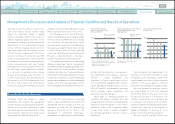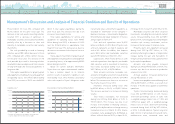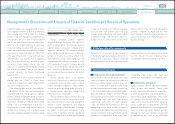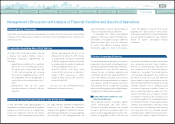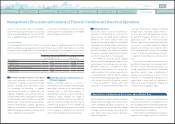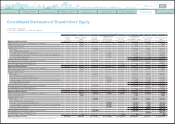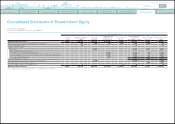Toyota 2012 Annual Report Download - page 72
Download and view the complete annual report
Please find page 72 of the 2012 Toyota annual report below. You can navigate through the pages in the report by either clicking on the pages listed below, or by using the keyword search tool below to find specific information within the annual report.
TOYOTA ANNUAL REPORT 2012
Toyota Global Vision Changes for Making
Ever-Better Cars President
ʼ
s Message Medium- to Long-Term
Growth Initiatives Special Feature Management and
Corporate Information Investor Information
Business and
Performance Review Financial Section
Management's Discussion and Analysis of Financial Condition and Results of Operations
Toyota does not have any significant related party transactions other than transactions with affiliated
companies in the ordinary course of business. See note 12 to the consolidated financial statements for
further discussion.
In June 2011, FASB issued updated guidance of
presentation of comprehensive income. This guidance
requires to present the total of comprehensive
income, the components of net income, and the
components of other comprehensive income either
The consolidated financial statements of Toyota are
prepared in conformity with accounting principles
generally accepted in the United States of America.
The preparation of these financial statements
requires the use of estimates, judgments and
assumptions that affect the reported amounts of
assets and liabilities at the date of the financial
statements and the reported amounts of revenues
and expenses during the periods presented.
Toyota believes that of its significant accounting
policies, the following may involve a higher degree
of judgments, estimates and assumptions:
Toyota generally warrants its products against
certain manufacturing and other defects.
Provisions for product warranties are provided
for specific periods of time and/or usage of the
product and vary depending upon the nature of the
product, the geographic location of the sale and
expect this guidance to have a material impact on
Toyota
ʼ
s consolidated financial statements.
In December 2011, FASB issued updated
guidance of disclosures about offsetting assets
and liabilities. This guidance requires additional
disclosures about gross and net information
for assets and liabilities including financial
instruments eligible for offset in the balance
in a single continuous statement of comprehensive
income or in two separate but consecutive
statements. This guidance is effective for fiscal year,
and interim period within the fiscal year, beginning
after December 15, 2011. Management does not
other factors. All product warranties are consistent
with commercial practices. Toyota includes a
provision for estimated product warranty costs
as a component of cost of sales at the time the
related sale is recognized. The accrued warranty
costs represent management
ʼ
s best estimate at
the time of sale of the total costs that Toyota will
incur to repair or replace product parts that fail
while still under warranty. The amount of accrued
estimated warranty costs is primarily based
on historical experience of product failures as
well as current information on repair costs. The
amount of warranty costs accrued also contains
an estimate of warranty claim recoveries to be
received from suppliers. The foregoing evaluations
are inherently uncertain, as they require material
estimates and some products
ʼ
warranties extend
for several years. Consequently, actual warranty
costs may differ from the estimated amounts
and could require additional warranty provisions.
If these factors require a significant increase in
sheets. This guidance is effective for fiscal year
beginning on or after January 1, 2013, and for
interim period within the fiscal year. Management
does not expect this guidance to have a material
impact on Toyota
ʼ
s consolidated financial
statements.
In October 2000, the European Union enforced
a directive that requires member states to
promulgate regulations implementing the
following:
• manufacturers shall bear all or a significant
part of the costs for taking back end-of-
life vehicles put on the market after July
1, 2002 and dismantling and recycling
those vehicles. Beginning January 1, 2007,
this requirement will also be applicable to
vehicles put on the market before July 1,
2002;
• manufacturers may not use certain
hazardous materials in vehicles sold after
July 2003;
• vehicles type-approved and put on the
market after December 15, 2008 shall be
re-usable and/or recyclable to a minimum
of 85% by weight per vehicle and shall be
re-usable and/or recoverable to a minimum
of 95% by weight per vehicle; and
• end-of-life vehicles must meet actual
re-use of 80% and re-use as material or
energy of 85%, respectively, of vehicle
weight by 2006, rising to 85% and 95%,
respectively, by 2015.
See note 23 to the consolidated financial
statements for further discussion.
Related Party Transactions
Recent Accounting Pronouncements in the United States
Critical Accounting Estimates
Legislation Regarding End-of-Life Vehicles
■
Product Warranties and Recalls and
Other Safety Measures
0820
Search NextPrev page 72
Contents








